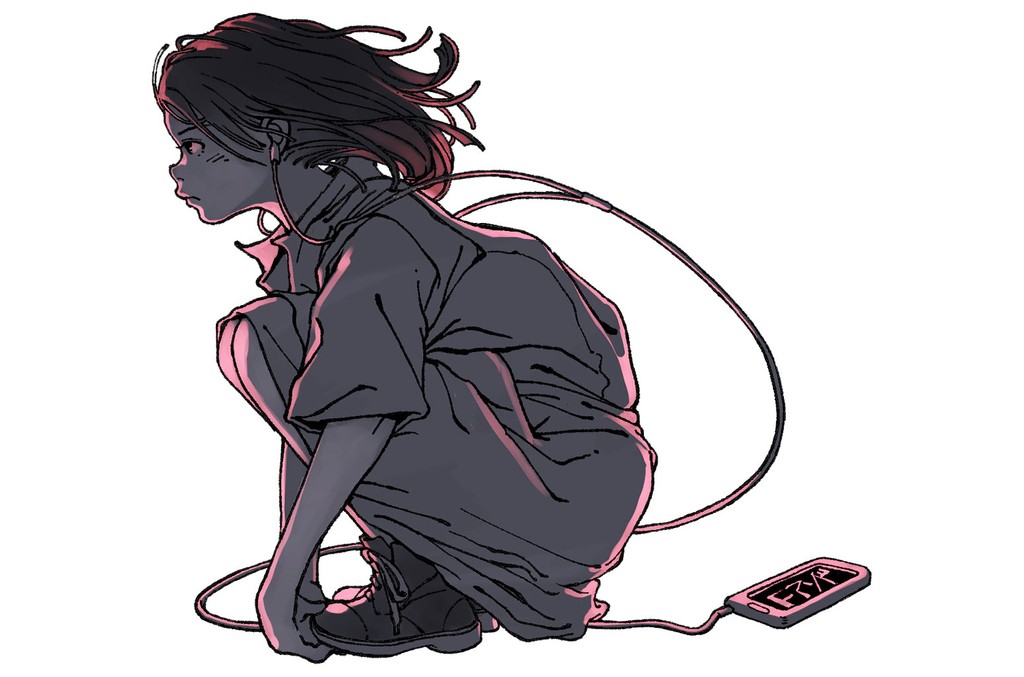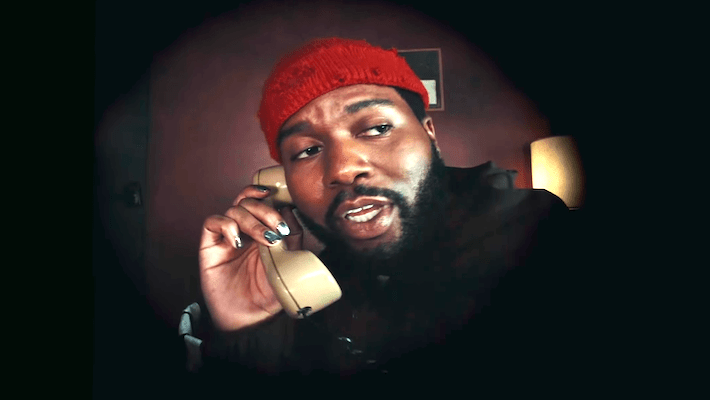YOASOBI is a breakout J-pop act whose debut single, “Yoru ni kakeru,” has been taking various Japanese music rankings by storm. The male-female duo formed for a project by the online creative writing site monogatary.com, and its unique concept is to produce music inspired by stories submitted to the site.
Released in December 2019, “Yoru ni kakeru” — which can roughly be translated to “Racing into the night” in English — is based on an original short story by Mayo Hoshino titled “Thanatos no yuuwaku” (“Seduction of Thanatos”) that depicts the fleeting romance between the first-person narrator, presumably a young man, and the woman he loves who repeatedly tries to commit suicide.
“Yoru ni kakeru” first took off on the short video platform TikTok and other social media, leading Spotify’s Viral Top 50 (Japan) ranking in January. The animated music video directed by Niina Ai, currently a student at the Tokyo University of Arts Department of Design, has been viewed over 30 million times. The at-home single-take performance of the song by vocalist ikura uploaded May 15 on YouTube’s The First Take channel has also been viewed over 20 million times.
The duo’s first single has gone on to become its first No. 1 hit on the Billboard Japan Hot 100, leading the chart dated June 1 and staying there for three straight weeks. Billboard Japan spoke with the members — Ayase, the songwriter and producer who started releasing music online as a so-called “vocaloid producer (vocalo-p)” in December 2018, and singer ikura, a university student who also writes and performs her own music as Lilas Ikuta — and asked about the group’s origins, the members’ musical influences, the process behind their songwriting and more in this in-depth interview.
How did YOASOBI originally get started?
Ayase: There’s an online creative writing site called monogatary.com, and I received an offer from the staff there to collaborate on a unit that creates music inspired from original stories. So after discussing things like what kind of vocalist we wanted and the direction of the music we were aiming for, we found ikura on Instagram — where she had uploaded some of her music — and formed our duo.
What are your musical influences?
Ayase: I grew up on mainstream J-pop artists like aiko, Sukima Switch, Kobukuro and EXILE. They were major influences, so when I make my own music — whether it be vocaloid tracks or songs for YOASOBI — I don’t have a sense of doing anything particularly offbeat and always aim to straightforwardly create the best kind of J-pop.
Where do you think those influences are most apparent in YOASOBI’s songs?
Ayase: The way the melody works. Aside from J-pop from the aughts that I mentioned, I also listen to a lot of mainstream J-pop from the ’80s and ’90s, so I like the kind of melodies Japanese people are familiar with. But I do want to stick to global trends as well in terms of the overall sound, and currently listen to a lot of K-pop in particular. I find the way they make their tracks really enlightening.
ikura: I grew up in the States until I was 3 years old, and listened to a lot of Western music from a young age. When I was in elementary school, I watched a lot of programs on the Disney Channel and bought the soundtracks to practice singing the songs in English. I think the way I sing now has a lot to do with my experience from back then. Also, my father likes folk music and he taught me how to play the guitar. I listened to a lot of folk and country music up to my early teens, so those kinds of simpler tunes are my influences as well.
You both have separate music careers aside from YOASOBI — Ayase as a “vocalo-p” and ikura as a solo singer-songwriter. Do you feel that your dual careers influence each other in tangible ways?
Ayase: I make the demos for YOASOBI using vocaloid software, actually, because I can be more innovative with my ideas when I’m writing the melody. That’s why sometimes they’re incredibly hard for a living vocalist to take breaths while singing them. But in the early idea stages, there’s a different kind of excitement compared to writing a song while actually singing it, so that’s something I was able to notice because I’m a vocalo-p.
ikura: Ayase can position notes anywhere and make songs using any kind of rhythm, and I’m always surprised by the breadth of his ideas every time I hear a new song he wrote. But I have to admit, there are parts I find difficult, like when a note jumps an octave or the tempo is a lot faster than the music I make. So, I need to keep improving in those respects.
Can you elaborate on your process of writing music based on stories?
Ayase: I guess it goes without saying that I start off by thoroughly studying the story. Except I primarily compose the music first and add the lyrics later, so usually set aside the finer parts of the storyline for the time being and determine the overall style first, like the tempo and sound. It’s pretty much an intuitive process for me. Kind of like playing the music in my head while I’m reading the original story. I think the result is faithful to the work it’s based on.
“Thanatos no yuuwaku” (“Seduction of Thanatos”) is a story that reflects the way the author views life and death. But the song that was inspired by it, “Yoru ni kakeru” (“Racing into the night”), has a kind of drive to it, with powerfully energetic vocals, which veers away from the serious tone of the story itself.
Ayase: I figured if I were to write a gloomy tune to express “Thanatos no yuuwaku,” it would just become unbearably bleak, so I made it catchy and pop on purpose. I wanted to express the grotesque that resides within beauty and cuteness.
ikura: I wanted to maintain the mood of the original work, so I kept my vocals neutral, to blend in with the color of the track. I tried to convey the emotion of the protagonist with my voice.
On the other hand, your second release, “Ano yume wo nazotte” (“Tracing that dream”), sonically expresses that kind of restlessness of being head-over-heels in love, in keeping with the romantic story it was based on. Was the process for this track different from “Yoru ni kakeru”?
Ayase: Yes, definitely. Precognitive dreams are key in the original story, and it has elements of fantasy, so I started off making a near-futuristic, slightly eccentric track, but it didn’t feel right. I decided to highlight the bittersweet aspect of romance and the kind of rush of being young instead. It’s a straightforwardly exhilarating song, but the original story has an unexpectedly complicated twist to it, so that difference is interesting, too.
What about your third release, “Harujion”?
Ayase: The story it’s based on is about a protagonist who got dumped and is in a funk, but eventually begins to pursue a dream. So I wanted to express the way they face forward and start to move on up. The story had a lot of indoor scenes, so I linked the image of emerging from that room with the sense of taking a new step forward towards one’s dream.
Also, the timing of the release happened to coincide with the coronavirus quarantine in Japan. I figured people wouldn’t be able to feel the coming of spring this year, so to convey a sense of season through music, I aimed to create a spring-like sensation of everything beginning to open up.
ikura: The music unfolded along with the development of the story, so I focused on that. I sing this one in a smoother way compared to the other YOASOBI numbers, which I sing in a sharper, more rhythmical manner. I also gradually increased the intensity from the bridge before the last chorus to the end of that part to express the way the protagonist rises upward and onward.
“Yoru ni kakeru” started buzzing on social media from around the beginning of this year, and went on to become your first No. 1 on the Billboard Japan Hot 100 and stayed there for three consecutive weeks. The song gained popularity with incredible speed. When did you first sense that the tide was turning?
Ayase: (Because of coronavirus quarantine) people are now looking for things to enjoy at home, so the types of entertainment they want have changed. I think there’s a bigger opportunity for our music to be heard. It began taking off on places like TikTok and Twitter around February to March, which coincides with the beginning of businesses being asked to shut down, so I guess we were fortunate in that the timing of social distancing brought us opportunity.
ikura: I think one of the real joys of YOASOBI’s music is how people can go back and forth between the original stories and music videos to enjoy them together, so the fact that people have more time to do so makes a big difference.
What are some other inspirations from daily life that you reflect in your music?
Ayase: I watch a lot of anime in my free time, and often write music right after I’m moved by a particular story. This is something I’ve done for a long time — things like movies, too, I’m the type who wants to make something out of my reaction to a particular work of art. An illustrator might express it through drawings, and I do so through music. Whenever I feel a strong emotion after seeing anime and movies, I channel those feelings into my music.
That sounds a lot like what you do for YOASOBI.
Ayase: Yeah, I guess you could say that I’ve been doing the same thing for a long time. When I was around 16 or 17, an older band member told me, “It’s fun writing songs pretending to be the protagonist of an anime and stuff, or imagining what you would say to that character. It’ll broaden your scope.” I took their advice and got good results. So maybe I’m cut out to make music this way.
ikura: I also write a lot of my music after seeing a movie, or after reading a book. I also like gazing at scenery and am inspired by visual cues like buildings and the color of the sky that I see when I’m riding a train or just walking outside, and often stop to jot down lyrics on the spot.
Lastly, can you share some of your upcoming projects and what you envision for YOASOBI’s future?
Ayase: We’re currently busy working on a new song, and it’s turning out great. We intend to keep writing more songs and put out an album, and when the situation allows, we’d love to perform live as well. Right now, we have a lot of time to plan out our strategy, so we’ll keep preparing to make sure we can present excellent quality when the time comes.



